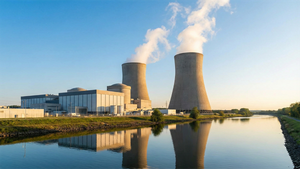
Electrical safety company Atkore (NYSE: ATKR) met Wall Street’s revenue expectations in Q2 CY2025, but sales fell by 10.6% year on year to $735 million. Its non-GAAP profit of $1.63 per share was 3.2% above analysts’ consensus estimates.
Is now the time to buy ATKR? Find out in our full research report (it’s free).
Atkore (ATKR) Q2 CY2025 Highlights:
- Revenue: $735 million vs analyst estimates of $738.6 million (10.6% year-on-year decline, in line)
- Adjusted EPS: $1.63 vs analyst estimates of $1.58 (3.2% beat)
- Adjusted EBITDA: $99.92 million vs analyst estimates of $99.85 million (13.6% margin, in line)
- Management raised its full-year Adjusted EPS guidance to $6.50 at the midpoint, a 3.2% increase
- EBITDA guidance for the full year is $400 million at the midpoint, below analyst estimates of $402.7 million
- Operating Margin: 8.7%, down from 20.5% in the same quarter last year
- Organic Revenue fell 10.3% year on year vs analyst estimates of 9.7% declines (55.8 basis point miss)
- Market Capitalization: $1.92 billion
StockStory’s Take
Atkore’s Q2 performance met Wall Street’s revenue expectations but prompted a significant negative market reaction, with shares declining sharply after the results. Management attributed the year-over-year revenue decline to lower average selling prices in key product categories, especially PVC and steel conduit, offset only partially by modest volume growth and productivity gains. CEO Bill Waltz specifically cited the evolving tariff environment as a source of both direct cost pressure and market uncertainty, affecting both sales and input costs. Waltz also acknowledged that recent pricing improvements in steel conduit were not enough to counter rising raw material costs, notably copper and aluminum.
Looking forward, management’s updated guidance reflects persistent headwinds from raw material volatility, tariffs, and muted demand in certain end markets. Waltz indicated that additional tariffs and changes in market pricing will continue to weigh on margins into next year, stating, “We expect these pressures to persist into next year, and we are actively evaluating various levers to help mitigate their impact.” The company emphasized ongoing operational discipline and efforts to recapture market share in domestically manufactured products as key strategies to offset these challenges. The upcoming CEO transition adds another layer of uncertainty as the company navigates a complex operating environment.
Key Insights from Management’s Remarks
Management highlighted several operational and market dynamics that influenced Q2 results, including shifting demand patterns, tariff impacts, and product-specific pricing trends.
- CEO retirement announced: CEO Bill Waltz revealed his decision to retire, with a succession process now underway. He committed to a seamless transition but acknowledged the leadership change comes at a pivotal time for the company.
- Tariff environment evolving: The introduction and modification of tariffs—especially the increase on steel and aluminum imports—directly impacted both input costs and market pricing, with management noting declines in imported steel and PVC conduit volumes.
- Mixed construction sector sentiment: Management observed varying levels of activity across nonresidential construction segments, with some pockets of strength (such as data centers and solar) but overall subdued demand in other verticals.
- Sequential pricing improvement: The company saw a second consecutive quarter of improved pricing in steel conduit and other products, but these gains did not fully offset higher raw material costs, particularly for copper and aluminum.
- Productivity gains in S&I segment: The S&I (Safety & Infrastructure) segment delivered year-over-year margin improvement due to better productivity and cost management, partially mitigating the margin compression in the Electrical segment.
Drivers of Future Performance
Looking ahead, Atkore expects ongoing headwinds from tariffs, raw material volatility, and muted demand in certain markets to weigh on both revenue growth and margins.
- Tariffs and raw material costs: Management expects continued direct and indirect impacts from tariffs on steel, aluminum, and copper, with higher input costs challenging the company’s ability to maintain margins. The company does not anticipate the recently announced copper tariff to negatively affect its supply, but the increased aluminum tariff is seen as a cost headwind.
- Market share recovery in steel conduit: Atkore aims to recapture market share lost to imports in steel conduit, leveraging the new tariff regime and an anticipated shift in demand back toward domestically manufactured products. This is expected to be a gradual process, with management noting potential volume growth in this product line.
- Choppy demand and pricing conditions: The company sees uneven demand across end markets, with data centers and solar showing some optimism, while other sectors remain subdued. Sequential price improvements in some products are a positive sign, but management cautions that PVC conduit pricing may continue to decline into next year, creating revenue and margin headwinds.
Catalysts in Upcoming Quarters
Looking ahead, our analyst team will be closely monitoring (1) the impact of evolving tariff policies and their effect on input costs and pricing power, (2) whether Atkore can successfully regain market share in steel conduit and other domestically sourced products, and (3) the execution of productivity and cost control initiatives to offset persistent margin pressures. The timing and outcome of the CEO succession process will also be a notable factor in upcoming quarters.
Atkore currently trades at $56.99, down from $76.57 just before the earnings. In the wake of this quarter, is it a buy or sell? Find out in our full research report (it’s free).
Stocks That Trumped Tariffs
Donald Trump’s April 2025 "Liberation Day" tariffs sent markets into a tailspin, but stocks have since rebounded strongly, proving that knee-jerk reactions often create the best buying opportunities.
The smart money is already positioning for the next leg up. Don’t miss out on the recovery - check out our Top 6 Stocks for this week. This is a curated list of our High Quality stocks that have generated a market-beating return of 183% over the last five years (as of March 31st 2025).
Stocks that made our list in 2020 include now familiar names such as Nvidia (+1,545% between March 2020 and March 2025) as well as under-the-radar businesses like the once-small-cap company Exlservice (+354% five-year return). Find your next big winner with StockStory today.
StockStory is growing and hiring equity analyst and marketing roles. Are you a 0 to 1 builder passionate about the markets and AI? See the open roles here.





